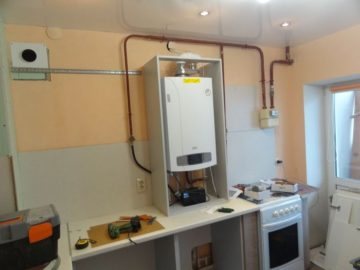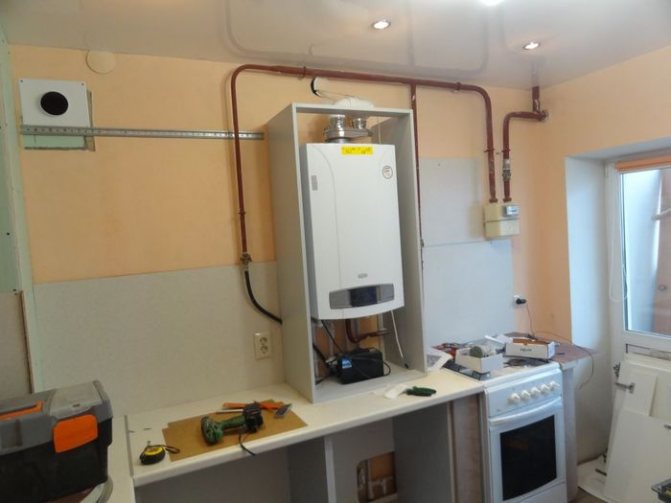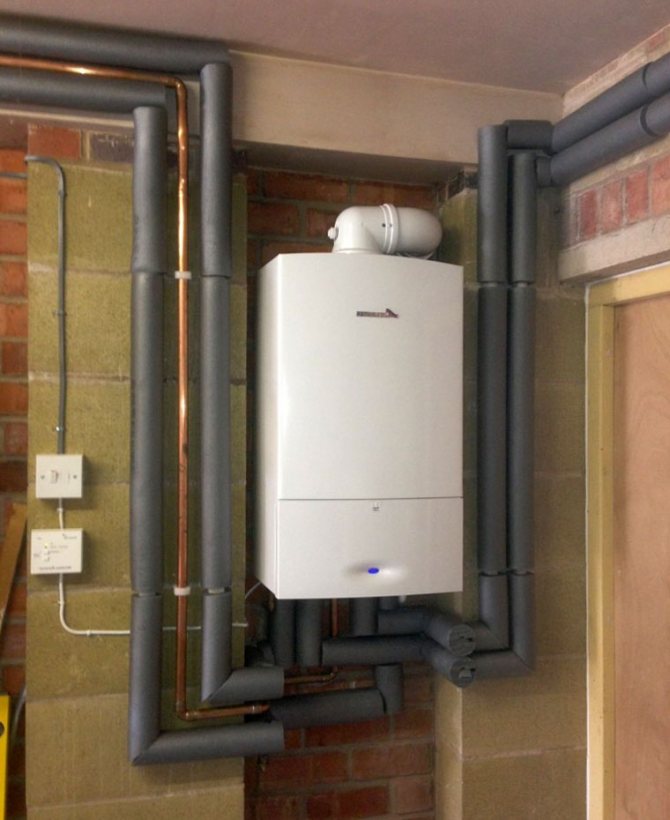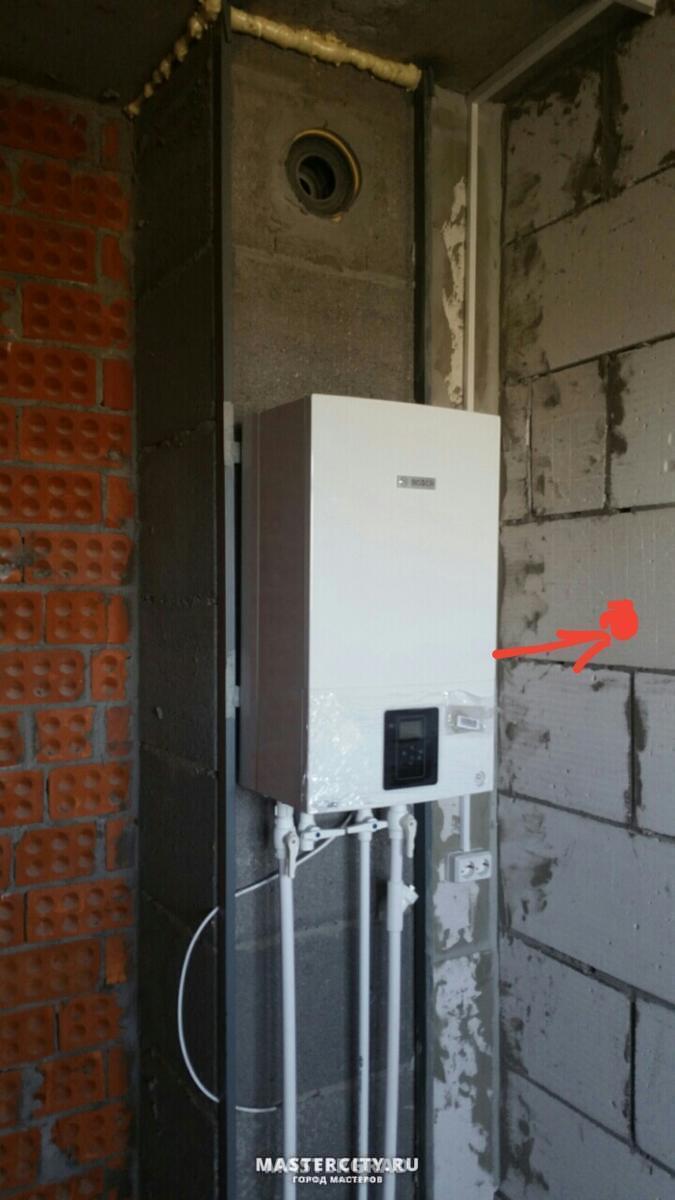Is it possible to move a gas boiler to another room and place it in a different place ... Many people want to move gas heat generating equipment - a boiler or a water heater, to another wall, for example, or even outside the room. The easiest way to do this ... One should be guided by the norm SP 62.13330.2011 "Gas distribution systems", and others, to which he refers ...
Is it possible to transfer a gas water heater or boiler to another room
You can't just take and move the boiler or gas water heater to another room. The gas connection to the devices is usually done with a flexible hose, which is used as a corrugated stainless steel tube, the so-called "gas pipe". In this regard, there is a clause of standards that are not allowed to cross any structures, window, door and other openings with a flexible gas supply.
Thus, we cannot just take and install a long flexible connection, and with its help drag the boiler into the next room, because we will definitely cross something that cannot be crossed ... By this point, the boiler is tied to the room into which the stationary steel rigid gas pipes ...
Any action with gas equipment - only with the knowledge of the gas service.
It is forbidden to install gas equipment - a boiler or a water heater ... outside of compliance with the project. And the project must be approved and agreed in accordance with the regulations. Moving the boiler somewhere else entails a change in the documentation. Therefore, the first step, if you want to transfer a gas heater or boiler equipment on gas, is to contact the gas service ...
And then - where will they send ..., depending on the severity of the situation and the complexity of resolving issues in a particular department. All standards can sometimes be interpreted more mildly, especially since all these documents are sinful of inaccuracies and ambiguities ...
Why are there gas water heaters in the bathrooms in old houses?
Regulatory requirements change in accordance with new technology, new knowledge and new experience gained. Safety rules in any area are constantly being improved.
Previously, when gas water heaters were installed in "stalinkas", it was allowed to install heat-generating gas equipment in the bathrooms. Now it is not allowed, and no one will let the newly purchased column be put there. Such a project will not be developed or approved.
Another thing is that consumers manage to call the bathroom the second kitchen in the documents ... Indicate that there are no appliances with open water in it. For the time of installation, take out the shower and the toilet from there too….
Thus, it is theoretically possible to put a gas water heater in the bathroom today. Another thing is that it needs to be serviced, and the personnel of the gas services can quite reasonably make serious claims for the violation of the operation of gas equipment, if they find a shower head next to the boiler or column ...
Is it possible to transfer a gas water heater from the corridor to the kitchen
Is it permissible to remove the gas boiler from the corridor to the kitchen, where it belongs ... It is recommended to place gas equipment in utility rooms, where it interferes with noise less and does not coarse the interior. In kitchens, a gas boiler or a water heater interferes with both noise and cluttering of the space. But standards are allowed to install them in kitchens.
Why is it possible in kitchens if there is a sink, open water? Why is a sink better than a toilet bowl or a sink in a bathroom ... Gas service specialists have no answer to this simple question.They only know what is written in the standard - you can do it in the kitchen, you can't do it in the bathroom, that's all, and no reasoning.
Why is it difficult to move a gas boiler to another room
It is necessary to draw up, coordinate and approve the corresponding technical documentation, which is difficult. In practice, you will have to dismantle, clean and redo (digest) the supply gas pipeline, bring it into the room where the new project requires you to install a boiler or a column.
However, in many branches of gas services, they are glad to have such customers who rush around with their boilers and are ready to pay for any whim. Therefore, there are quite a few whims for those wishing to move the boiler to another room, from all the services of signing, approving and assembling.
Is it possible to move the boiler from the kitchen to the corridor or to the closet ...
The boiler and other gas equipment can be moved from the kitchen to the pantry or corridor, or to another utility room, if a number of regulatory requirements are met there. In particular, the following is required.
- The room should be equipped with exhaust ventilation, which provides three times air exchange per hour. This is usually provided by pipes of 150 mm in diameter with a small volume of the room.
- The structures must have air inlets from 200 cm square. with inflow from other premises or from the street.
- The volume of the room must be at least 7.5 cubic meters for one boiler up to 60 kW. The room should have a window of 0.8 sq. In this case, the height of the room must be more than 2.0 meters.

If you decide to carry out the transfer of the gas boiler, coordination of these actions must be made with the gas supply company. Unauthorized alteration of the gas heating system threatens the owner with serious sanctions from the inspection services.
How to get the consent of the gas workers to move the gas boiler?
Any fundamental change in the heating system should be made to the existing project. This also applies to the transfer of a gas boiler in an apartment or private house. Permission for this action should be obtained from the gas supplying organization. This process involves the following steps:
- If the transfer of a gas boiler in a private house is carried out to a newly built extension - a boiler room, then it should first be included in the building registration certificate.
- With the technical passport of the house and the old project of gas heating, the owner goes to the gas service and writes an application for the transfer of gas equipment indicating the installation location and the size of the boiler room.
- Specialists of the gas service develop a project for the transfer of a gas boiler and issue it to the applicant.
- Then the gasmen, in accordance with the project, carry out the transfer of the equipment, connect it and check the system operability.
- If the gas boiler is operating normally, an act is issued.
- With the act, the owner goes to the gas service, registers the place of installation and the number of transferred units.
Read more Insurance company hope bankruptcy or not
To save money, some users of gas boilers decide to do the main work on the transfer of the gas boiler with their own hands. Such actions are not prohibited, but the connection of the device to the gas main and its first start-up must be carried out by a gas service specialist.


Before starting to dismantle the gas boiler from the old place, it is recommended that you familiarize yourself with the documents that govern the rules for installing such a device:
- SNiP 42-01-2002 "Gas distribution systems";
- "Safety Rules for Gas Distribution and Gas Consumption Systems";
- OST 153-39.3-051-2003 “Technical operation of gas distribution systems. Basic provisions. Gas distribution networks and gas equipment of buildings. Tank and balloon installations ".
It is important that the new room, into which the gas boiler is being transferred, complies with all existing standards.
Read here - rules and regulations for the installation of a gas boiler
Moving a gas boiler to another place in a private house
I live in a private house. Gas is supplied to the house and a gas boiler for heating and a gas stove are installed. We decided to make an extension to the house (bathroom, toilet and boiler room). We want to move the gas boiler there and additionally install a gas water heater for heating water for the bathroom.
Please tell me if you need to get a special permit to relocate a gas boiler and install additional gas equipment in a private house, and if so, from which services? How to properly arrange gas equipment for operation later?
Stages of transferring a gas boiler
The transfer of a gas device consists of two main stages: dismantling the boiler from the old place and installing it on a new one.
To ensure that there is a minimum period of time between these actions, you should prepare a new room in advance for the installation of a gas boiler:
- bring water and gas pipelines to a new location;
- put an outlet next to the future unit, if it is missing;
- prepare the installation site: hang a shield made of refractory material (metal) for the mounted unit on the wall, put a fireproof base on the floor or form a concrete screed - for a floor analog;
- make a hole in the ceiling or wall for the chimney;
- remove flammable objects from the room.
It is also necessary to make sure that the volume of the room corresponds to the capacity of the gas boiler. It cannot be less than 7.5 m³ - this is the minimum allowable volume of the room in which it is allowed to install the gas unit. Ceiling height - from 2 m and more.


Dismantling the gas boiler
Dismantling the gas boiler is carried out in the following stages:
- Shut off the gas pipe.
- Flush the entire heating system.
- Turn off the boiler from the socket, disconnect the chimney, water pipes and sewerage from the unit.
- Remove the hinged device from the brackets.
Unit installation
The main stages of installing a gas boiler are as follows:
- Chimney preparation: installation of a pipe in an opening with a slight slope towards the street to drain condensate. The coaxial chimney is inserted into the hole and secured with wedges, after which the empty space is filled with cement or polyurethane foam.
- Using the template for the back wall of the hinged gas boiler, mark the places on the wall for installing the brackets and attach them.
- Wall-mounted models are hung on brackets, and floor-standing models are placed exactly on a fireproof base.
- Connect the boiler pipe to the chimney through a special elbow.
- Connect the heating and water supply system to the unit circuit. If the model is double-circuit, then hot water supply is also supplied.
- Install a gas duct - a metal flexible hose is best suited, but a gas service representative must connect it.
- Plug the device into a power outlet and connect to ground.
- You can independently check the system for leaks.
- A specialist is invited to carry out the first start-up of a gas boiler.


Before carrying out the transfer of the heating device, it is worthwhile to think once again how expedient it is, since such a manipulation is not cheap at all. For example, transferring a gas boiler to a loggia makes sense only if this room is insulated and will be heated as part of the living area.
When buying an apartment, the developer offered the option to move the boiler to another part of the apartment, we did not want to, having notified him about this, we ordered the project from the designer. The project is ready, we are ready to start repairs, The apartment is owned. This developer is the ground, he says that he does not remember anything and wants to move us our boiler to where, according to the project, we have a bedroom, for the sake of some new buyers of an apartment under ours (they want to make a kitchen with a gas boiler under our bedroom). We are against the transfer of our boiler. And does the developer have the right to do so?
Lawyers Answers (2)
Not all points are clear, please explain in more detail
Do you have a children's home or did you buy a ready-made apartment?
Is there a plan of the apartment with an indication of the location of the boiler attached to the contract?
What does the contract say about the boiler?
That is, you have already accepted the apartment and registered the ownership? Then on what basis does the developer intend to move anything in your apartment?
Submit a statement to the police (you can even through the website of the police department of your area) about illegal entry into the apartment and damage to property.
Send a claim to the developer to eliminate the damage caused to the property and bring the interfloor overlap in accordance with the design documentation.
Well, as I wrote above: a statement to the housing inspectorate and the prosecutor's office
Let him send all his demands to the court. So you can answer him that any changes are possible only by a court decision, for which the developer has practically no chance
Bkz of our knowledge, they have already opened our apartment
And this is already grossly illegal and borders on a criminal offense, on this fact it is worth contacting the police
You can also go to court for compensation for damages caused by cutting a hole in the field.
Civil Code of the Russian Federation Article 15. Compensation for losses
1. A person whose right has been violated may demand full compensation for the losses caused to him, if the law or contract does not provide for compensation for losses in a smaller amount.
2. Losses are understood as expenses that a person whose right has been violated has made or will have to make in order to restore the violated right, loss or damage to his property (real damage), as well as lost income that this person would have received under normal conditions of civil turnover, if his right had not been violated (loss of profits).
Complaining to the authorities - submitting an application to the police, a complaint to the Federal Service for Supervision of Consumer Rights Protection and Human Rights, the housing inspection
In your situation, the developer is definitely wrong.
And how to protect and explain
There is no need to explain anything, the developer is already aware that he is wrong, but he expects to get what he wants in one go. Therefore, further communication with the developer is only formal and official.
The device of gas communications in the apartment is subject to certain requirements, therefore, independent installation and connection of equipment, as well as the transfer of the gas pipe to another place, is strictly prohibited.
Read more The difference between imprisonment and restraint of liberty
All questions regarding the laying of internal and external gas pipelines are resolved by the gas service, without whose permission it is only possible to move the stove a limited distance.
We will tell you how to get an approval for the replacement of a gas pipeline, and also describe the technology for transferring an intra-apartment pipeline. The proposed instructions are not a guide to action, all work must be carried out by a representative of the gas service.
Redevelopment of an apartment with a gas stove
Most often, owners want to produce combining kitchen with room, or leave an empty one between them opening in the wall... Let's say right away that all these procedures are impossible. Clause 11.18 of Appendix 1 PPM 508 in edition 840 does not allow combining a gasified room with a living room.
Interesting: A copy of the decision to refuse to initiate a criminal case
If the wall separating the kitchen and the room is not load-bearing, it is dismantled, and sliding sliding doors or an accordion partition are installed instead. However, the last decision does not guarantee one hundred percent that such a redevelopment will be approved by the government.
Reasons for transferring gas pipes in the kitchen
All work on the transfer and replacement of metal pipes, especially those requiring welding, is carried out by representatives of the Gorgaz or another authorized organization. Having received an application from tenants, they are always interested in the reasons for the planned transformations.
Most often, you need to change the piping in the kitchen without changing the layout and transferring equipment to other rooms.
The reasons can be different:
- replacing old equipment - buying a gas water heater, stove or boiler - for which a little more space is needed;
- major repairs in the kitchen;
- transfer of the gas stove from the window by 0.5-2 m towards the sink;
- change of the place of installation of the gas meter;
- transfer of a horizontally located pipe from a great height under a tabletop, etc.
Often the transfer of pipes is required in new buildings, where the original location of significant kitchen objects defies logic and explanation: suppose, if in a 15-meter kitchen, the gas stove is near the window, the sink is in the opposite corner, and the hood is in the other side, above the kitchen entrance.
We have to correct the mistakes of the designers, move the stove closer to the sink, so that cooking takes place in a comfortable environment.
The most common reason is buying a new kitchen unit with built-in equipment (oven and hob). In this case, the pipes must either be shortened or lengthened, depending on the planned installation site of the devices.
If you want to know how best to transfer a gas pipe in an apartment with a redevelopment, we recommend that you contact the design organization to draw up a transfer scheme.
The fact is that in typical city apartments it is forbidden to reinstall risers, pipes, as well as any gas equipment into living rooms, and even to combine a kitchen and a room, a permit is also required.
How to move a gas boiler or column to another place
It is necessary to draw up, coordinate and approve the corresponding technical documentation, which is difficult. In practice, you will have to dismantle, clean and redo (digest) the supply gas pipeline, bring it into the room where the new project requires you to install a boiler or a column.
You can't just take and move the boiler or gas water heater to another room. The gas connection to the devices is usually done with a flexible hose, which is used as a corrugated stainless steel tube, the so-called "gas pipe". In this regard, there is a clause of standards that are not allowed to cross any structures, window, door and other openings with a flexible gas supply.
Obtaining approval for the replacement of a gas pipeline
Whether or not the transfer is possible can only be decided by authorized bodies, that is, the gas service of your city (district). Only a qualified specialist has the right to carry out any dismantling and installation work. Of course, without agreement, the transfer of pipes cannot be carried out.
The permit is issued in the following sequence:
- Find out the contact details of the gas service at the place of registration, contact the specialists, explain the situation, consult.
- Draw up a statement (in a standard form) that will "launch" the approval process.
- On the basis of the application, a representative of the gas service arrives at your home. The time is specified in advance.
- The specialist inspects, listens to wishes, answers questions. Often at this stage it is necessary to change plans, since the desired transfer does not meet safety requirements (a preliminary study of the gas pipeline installation standards will save you from this unpleasant moment).
- Approval of the final transfer scheme, budgeting. All documents are drawn up by the organization providing the services. No work is carried out without the consent of the homeowner.
- If the transfer conditions are met, you pay for the service according to the receipt and agree on the start time of work.
The approval procedure usually takes several days, it can stretch over a long period only for one reason: if the owners of the property and the representatives of the gas service did not find a compromise solution.
Any factors that violate the norms for the installation of gas stoves (boilers, meters, columns) can cause a refusal to transfer pipes.
How to move a gas water heater to another place
Despite the lack of direct and clear wording, it can be concluded from the provisions that the bathroom is not suitable for the location of the boiler. In any case, gas workers will not allow the installation of a water heater in the bathroom legally.
According to the listed normative and regulatory documents, the transfer of the geyser to another place must be carried out in compliance with the following conditions:
- the work will be performed by a specialist with the necessary admission;
- the connection will be made in accordance with the existing project.
Accordingly, independent dismantling and reconnection of gas equipment is considered a gross violation of regulations. If the work will be performed by a specialist, for example, a representative of the Gas Service, then the change in location must be agreed, as evidenced by the project indicating the new location of the column.
General requirements and standards
In order for the approval process to go smoothly, it is better to familiarize yourself in advance with the basic provisions of the gas system device in residential premises. As a cheat sheet, you can use a regulatory document - SNiP 2.04.08-87 * (current version).
If the walls and ceiling are made of flammable materials (wood), they must be plastered or covered with metal sheets.
Gas pipes are used to transport fuel to consumers - stoves, ovens, columns, so the location of the equipment is important no less than piping.
You also need to know that the shut-off valve cannot be cut off the pipe. This is an indispensable element of the gas system. Moreover, when changing the location and replacing the gas valve, it is necessary to ensure that it is in direct accessibility.
If it is placed under a worktop, then access should be through the cabinet door (without the back wall) or through an opening fragment of the worktop.
Safety requirements for redeveloping a kitchen with a gas stove transfer
- You need to place a gas hob or a separate stove at an interval of 50 cm from windows or doors. It is unacceptable to move the stove to the window. The prescribed distance cannot be arbitrarily reduced either. If a draft occurs, it can lead to the ignition of flammable objects or, on the contrary, extinguish the flame with the gas turned on.
- The stove should be located strictly near the gas distribution and ventilation compartment, with free access to the shut-off valve.
- If you are replacing a gas model with an electric stove, the wiring must be strong.
- You cannot put a gas stove in the corner near the refrigerator - as in any other place next to refrigeration equipment.
Interesting: How much interest should be withdrawn from a loan debtor with a second group of disabilities
Cutting off the shut-off valve pipe is inadmissible, it is an integral element of the gas system. It is impossible to independently replace even a flexible liner, and even more so to organize the movement or extension of pipes. This is done only by an employee of the gas service.
How to carry out a transfer or replacement
It is not recommended to change anything on your own, not even a flexible eyeliner. Cutting, building or transferring pipes should be carried out all the more by a representative of the gas service. However, knowing the sequence and some of the nuances of actions when working with pipes will not interfere with the homeowner.
# 1: getting ready to work with pipes
Usually a team of workers (most often 2 people) comes within the next week after agreement. At this point, it is already known which sections will be dismantled or lengthened, whether additional equipment will be installed, for example, a gas water heater. Consider what else is worth considering.
All the equipment used in the kitchen belongs to the owner of the apartment and is purchased at his expense, therefore, it is better to immediately ask what else you need to buy to transfer appliances and work with pipes.
When it comes to connecting a stove or oven, you will have to buy a bellows hose of a certain length. Installers bring metal pipes with them, their cost is included in the total amount of payment for services.
So that there are no hiccups, and the work goes quickly, you need to free up space from excess furniture or other items. Anything that cannot be taken out must be covered with a dense, non-combustible material.
# 2: dismantle an old structure
Most likely, when moving the pipe, you will need to cut off a piece of the old one and build up a new one, but in a different direction. To do this, the master, using a special tool, removes unnecessary pipe sections.
When dismantling the branch leading from the riser to the consumer, it is necessary to leave a small area on which the gas valve is attached. This horizontal piece of pipe must neither be removed nor changed. The only exception is pipeline damage requiring a complete replacement.
Occasionally, residents of the last floors require that a large piece of pipe that rises from the floor to the ceiling by 1.8 m and then bent downward by 180 ° be removed. It is strictly forbidden to cut the pipe and install a crane on the left section. The only way out is to digest the pipe so that the tap can be installed under the countertop, to a height of 0.75 m.
# 3: Options for changing the gas distribution
The transfer of pipes always occurs according to the same scheme: they are moved parallel to the ceiling or walls, since diagonal and any curved placement is prohibited. Consequently, most often the layering from the riser is lowered down, under the countertop (less often raised), or the vertical fragment is transferred to the right / left.
Read more Registration of a newly built private house
When changing the direction of pipes, remember the following rules:
- internal gas distribution is an open system, all covering elements are of camouflage nature and should not be firmly fixed;
- it is forbidden to lay the pipeline through ventilation ducts, as well as doors and windows;
- mainly metal structures are used; flexible hoses are allowed at the equipment connection areas, but their length should not exceed 3 m;
- a rigid method is used to connect pipes and hoses to pipes;
- pipe passages through walls / partitions are equipped with special adapters - sleeves.
Any work related to the transfer of pipes must begin with shutting off the gas. This is the responsibility of the service provider.
# 4: welding metal pipes
According to SNiP, any changes in the position of the pipes must be done by welding. Detachable connections of two sections are prohibited.
Threaded connections are used only when installing gas meters, household equipment and valves.
Places burnt by welding have an unpresentable appearance, moreover, they require protection from corrosion. After the end of the work, they must be treated with waterproof paint for metal, matched to the color of the walls.
# 5: using bellows hoses
Before extending or relocating a gas pipe, it is necessary to consider the option of installing a flexible transition. It is carried out using a bellows hose.
Previously, rubber and rubber-fabric products were used, but the bellows turned out to be stronger than outdated materials. At its core, it is a metal or composite corrugation, but it has unique qualities.
For a long time, it retains its tightness and elasticity even with active mechanical stress. The structure of the shell is retained even under strong pressure of the transported medium or under constant mechanical stress.
Installation of bellows connectors is also carried out by a gas service worker. He connects boilers, columns, stoves and ovens in accordance with all the rules of the PUE and, if necessary, uses adapters and seals, for example, FUM tape.
They try to hide gas pipes in the kitchen behind decorative panels or furniture. Pipeline masking options are described in this article.
Rules for redeveloping kitchens with gas stoves
The procedure for combining a kitchen with a living room is described separately if a gas stove is installed in the apartment. For safety reasons and to maintain the reliability of the building, such work is prohibited. Dismantling the partition between the room and the gasified kitchen can lead to increased damage in the event of emergencies in the gas supply system.
In accordance with modern standards, the distance between the gas stove and any plumbing equipment must be at least 30 cm. The gas hose must not be installed inside partitions or under furniture.
Interesting: Termination of the Land Lease Agreement Unilateral by the Administration
Conclusions and useful video on the topic
With the advent of long flexible hoses, the transfer of the internal gas pipeline has become less relevant, but in some cases you still have to contact the gas service. The most common reasons for requests are in the video presented.
Secrets of masking gas pipes:
About the transfer of the pipe and crane:
Welding work and transfer of the counter:
Finally, about the consequences of the illegal transfer of gas pipes. If you yourself are planning to cut off a piece of gas pipe or connect household equipment, you should be aware of administrative and criminal penalties.
The minimum fine for unauthorized work is 2 thousand rubles, and if a person suffers as a result of improperly performed work, he faces a term of up to 5 years in prison.
We invite everyone interested in the issue of transferring the gas pipe in the apartment to leave comments and ask questions. The contact form is located in the lower block.
Good evening everyone! Please tell me where to start and how to get around the bureaucracy of transferring a gas double-circuit boiler in a new building to the next wall. Delivery of the house is planned for the 4th quarter of the current year. The developer has managed to place the gas boiler, in our opinion, it is very inconvenient. After talking with the developer's manager today, I realized that until the soon delivery of the house, they will not be able to help in any way in terms of transfer. Everything falls on our shoulders from the moment we receive the keys. Questions:
- Is it generally legal to hang gas boilers on a wall with a chimney?
- Will it be very problematic to move the same boiler next to it, to the same corner on the next wall (I am attaching a photo)?
- Do you need a separate project?
- Where to begin?
- How much money will we have to say goodbye to?


- Quite. In many houses, gas water heaters and boilers hang just like that.
- Technically, no problem! I just don't see the gas pipe, have you done it yet? Where should the project be? And the counter is not in the same place where you want to put the boiler?
- In theory, no. It is just that changes are made to the existing one (and that is hardly possible). Start from where the gas pipe will be and agree with the installers to do what is convenient for you.
- This is a very difficult question, and hardly anyone will answer it even approximately. Well, if only someone specifically here will undertake to solder the pipes and announce the price (I would have transferred it for 3-4 thousand for work) business then.
Megavolt, thank you, you have calmed me down a little. They just scared me from all sides that everything connected with gas boilers and water heaters - transfers, projects, etc. turns into a hassle that can last a very long time. And we really want to move as soon as possible. As for the gas pipes, they haven’t been hung yet. But it will be right there, right from the boiler, above and into the chimney hole. Regarding the location of the future account, the developer's representative could not clearly answer me.
Another question is ripe: must I do the transfer of the boiler, having coordinated it with the city gas? Or can I through the company with which the developer worked? Or in private?
Go to the organization that will take the boiler into operation, and they are 1, 2, 3.Each city has its own organization, its own bosses, and there may be some special cockroaches.
Acer wrote: Go to an organization that will take the boiler into work, and they are 1, 2, 3. Each city has its own organization, its own bosses, and there may be some special cockroaches.
I also agree with this. But in most cases, no problems arise. I was also scared that it was not realistic to install a boiler instead of a column, but if it is really expensive, dreary and half a life of nerves. but now the boiler has been standing for half a year. The installers did not complete the commissioning according to the project. To the question: "then not to find fault?" - "no one will look at your project anymore!" And there is. when making changes to the gas region, they simply changed the connection SCHEME, replacing it with a sheet from the existing standard connection schemes, and by hand writing the brand of the boiler into it. At start-up, the gasman was not at all worried about the correspondence of the arrangement of the devices, but only the correctness of the circuit and the materials used.
Replacing a gas boiler in a private house: documents, rules for 2020
- Boiler performance is no longer satisfactory. If you made an extension or connected additional devices (for example, a boiler) to the circuit, then the old unit may not pull the load.
- Inappropriate functionality. Installing a double-circuit device instead of a single-circuit one allows not only heating the room, but also using hot water supply (DHW).
- Rationality issues. Standard boilers consume a lot of gas. But more modern condensing devices use not only gas, but also steam. This approach increases efficiency by 110%.
- Deterioration or breakdown of equipment.
- The organization of condensing boilers requires connection to the network, connection of the system for condensate drainage according to the rules.
- Before switching on, you will need to agree on the state of the chimney. The check is carried out by a gas service specialist. Thereafter, a similar audit will be carried out once a year.
- If you carry out independent work, you will not receive a guarantee.
Relocating the boiler from a regulatory point of view
Internal gasification project - a document containing detailed schematic information on the floor plan of a residential building with the definition of technical points for the location of gas-using equipment on a scale of 1: 100.
That is, moving a gas-using heat generator to another place is a violation of the design documentation and requires changes to it.
Let's see if it is generally possible to transfer a gas boiler to another place? And if so, what regulatory documents is it approved and where is it recorded?
The "housing issue" on the transfer of a gas boiler and other equipment in an apartment is determined by a number of articles of the ZhK (Housing Code) under number 25-29. And this process is called reorganization. The normative collection contains in detail all the information on the approval of the procedure, possible refusal and its objection, the consequences of unauthorized transfer, and so on.
These articles of the set of housing standards refer specifically to the premises of multi-apartment buildings, i.e. regulate measures and norms for the transfer of gas pipes, meters, boilers within apartments. However, this does not mean that no rules apply to private homes.
According to the decree of the State Construction Committee of the Russian Federation of September 27, 2003, clause 1.7., Only after obtaining permission, it is allowed to carry out re-equipment of premises for any purpose. In this case, the transfer of gas appliances falls under this definition.
Moreover, independent installation and replacement of a gas heat generator is not prohibited, but its admission to operation and connection must be carried out by employees of a gas supply company with an appropriate license.
In addition, the transfer of gas distribution, metering device and other gas equipment at home will have to be coordinated. For uncoordinated actions, you may be obliged to return all gas equipment to its original place.In this case, you will have to pay considerable fines for each of the displaced devices, even after reinstallation.
Administrative responsibility for unauthorized transfer of the boiler is determined according to the type and severity of the violation. There are penalties, obligations to return devices to their original place and even shutdown of gas supply. It is almost impossible to challenge the sanctions in court, because you in fact violate the prescriptions of the housing code.
The punishment is reasonable, because unprofessional installation of equipment, as well as a change in the project, is a gross disregard for fire safety requirements, a threat to the life and health of people living in the building, a violation of the engineering scheme of gas supply.

















